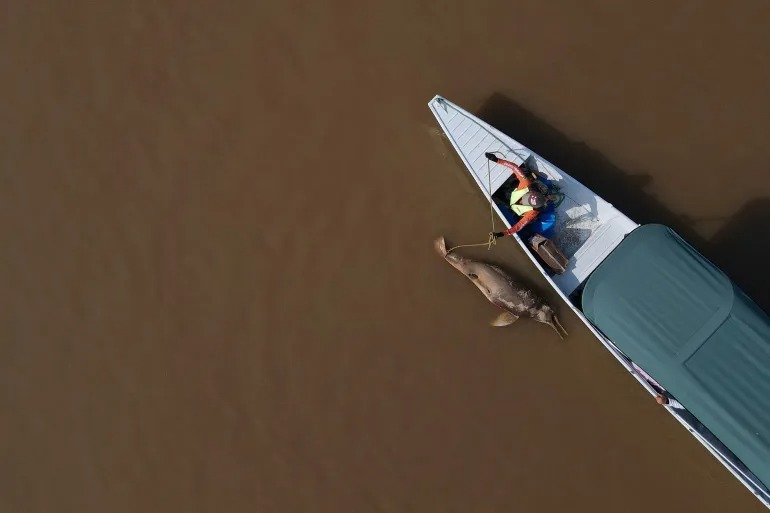The Amazon River’s iconic pink and grey dolphins are facing a severe crisis, with the deaths of 120 dolphins reported in the tributaries of Brazil’s Amazon River. Experts believe that these tragic losses are closely linked to the relentless onslaught of a severe drought and scorching heatwave. As the Mamiraua Institute, a renowned research group under Brazil’s Ministry of Science, Technology, and Innovation, investigates this alarming phenomenon, concern grows for the survival of these unique freshwater species.
Endangered Amazon Dolphins Face Grim Threat
These magnificent creatures, known for their striking pink hue, are among the world’s few freshwater dolphins, exclusively found in the rivers of South America. However, their slow reproductive cycles render them exceptionally vulnerable to threats. Miriam Marmontel, a researcher at the Mamiraua Institute, grimly reported, “We have documented 120 carcasses in the last week.” Astonishingly, around eight out of every ten casualties are the cherished pink dolphins, known as “boto” in Brazil. This alarming figure potentially represents a devastating 10 percent loss of their estimated population in Lake Tefe.
The “boto” and their grey river dolphin counterparts, the “tucuxi,” are already listed as threatened species on the International Union for Conservation of Nature’s red list. In response to this crisis, Brazil’s Chico Mendes Institute for Biodiversity Conservation has swiftly dispatched veterinarians and aquatic mammal experts to rescue any remaining dolphins in Lake Tefe.
Scientists Scramble to Uncover Causes
While the link between the catastrophic mortality rate and drought and heat is highly suspected, scientists are diligently working to confirm this theory. They are rigorously investigating other potential causes, including the possibility of a bacterial infection. However, the situation took a grim turn when over 70 dolphin carcasses surfaced last week, coinciding with a shocking water temperature of 39°C (102°F) in Lake Tefe. This is more than 10 degrees higher than the average temperature for this time of the year. Despite a brief decline, water temperatures resurged to 37°C (99°F) on Sunday, causing heightened concerns among experts.
Climate Change Blamed for Devastating Consequences
Environmental activists have pointed fingers at climate change, asserting that it has exacerbated the likelihood and intensity of droughts and heatwaves. Ayan Fleischmann, the geospatial coordinator at the Mamiraua Institute, emphasized the dire impact of the drought on riverside communities in the Amazon region, stating, “Many communities are becoming isolated, without access to good quality water, without access to the river, which is their main means of transportation.” The Mayor of Tefe, Nicson Marreira, echoed these concerns, noting that the city’s government struggled to deliver food to isolated communities due to dry riverbeds.
As the world watches in anguish, the plight of these Amazon dolphins serves as a poignant reminder of the urgent need to address climate change and its catastrophic consequences. With each passing day, the survival of these unique and cherished species hangs in the balance, underscoring the global responsibility to protect and preserve the rich biodiversity of the Amazon rainforest.
















